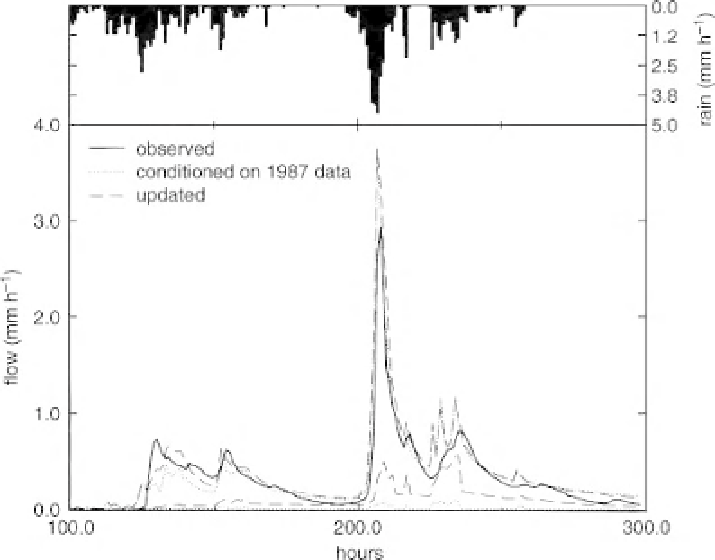Geoscience Reference
In-Depth Information
Figure 7.10
Prediction bounds for stream discharge from the Saeternbekken catchment for the 1989 sim-
ulations, showing prior bounds after conditioning on the 1987 simulation period and posterior bounds after
additional updating with the 1989 period data (after Lamb et al., 1998b, with kind permission of Elsevier).
sets conditioned on the earlier 1987 period, and also after combining with likelihoods calculated for the
1989 period itself. These images, therefore, represent prior and posterior likelihoods for this period. In
both cases, it can be seen that adding the information from the 1989 period leads to a narrowing of the
prediction bounds. For most of both sets of simulations, the observations are bracketed by the prediction
bounds but there are periods when the observations fall outside of the prediction bounds, indicating
some deficiencies in the model structure or input data used. The predicted borehole responses do not
show the same dynamic variation in the prediction bounds as the observations (although, as already seen
in Figure 6.8, individual simulations can reproduce the dynamics much more closely).
Lamb
et al.
(1998b) also examined the prediction of the spatially distributed piezometer data which
was available for five different discharges. All of the piezometers not indicating saturated conditions were
used in the conditioning process. A weight was given to the residual variance for each set of measurements
proportional to the number of points included. The results are shown in Figure 7.12. No account was
taken of the possibility of local variations in transmissivity (see discussion in Section 6.4). Interestingly,
the prediction bounds based on discharges and recording borehole measurements are much narrower
than those based on the piezometer data themselves. Even the latter, however, are not wide enough to
encompass a significant number of the data points. This indicates that either the model dynamics cannot
adequately reproduce the pattern of water tables in the catchment or local soil heterogeneity cannot
adequately be represented by catchment scale parameters. Certainly Lamb
et al.
(1997) have shown
that improved predictions can be achieved by allowing a local effective transmissivity value for each
piezometer site.
This study is of interest because of the way it used both discharge and internal water table measurements
to evaluate the model predictions and constrain the predictive uncertainty of TOPMODEL (see also

